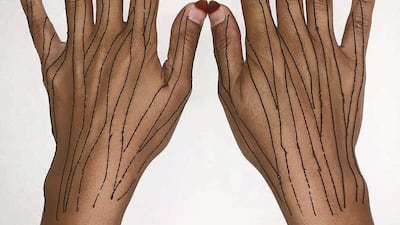As a young girl, Azra Khamissa, 29, remembers having her hands decorated with traditional henna in the build-up to Eid, a ritual that other female members of her family would join in with. Khamissa would sit still as henna artists adorned her fingers and palms with ornate lines and swirls. "I never liked what they used to do," she recalls. "I did it because I had to."
Over the next 25 years or so, Khamissa discovered a passion for henna, although her designs are very different from the patterns that graced the limbs of generations of Emiratis before her. As well as putting her own spin on traditional motifs such as the rawayeb (henna on the tips of the fingers) and rubeya (a circle on the flat of the palm), her hands have been covered with leopard print; she has traced the phases of the Moon from her wrist to the tip of her middle finger; and even used her palms as a canvas to take a stand.
Now she is inspiring a new generation to embrace the tradition, and it all happened by accident, really. Khamissa is a chiropractor by day, and the founder of handbag brand Azra. Henna was more of an experimental pastime, but after she posted a picture of her decorated hands on Instagram, Khamissa saw her innovative designs light a spark among her followers.
“Sometimes I’ll do Emirati designs, but give them a minimal, contemporary spin,” she says. “Other times, it could be nature or the human body that inspires me. It really depends on how I feel, and the good thing with the henna is that, because it’s temporary, there are no limitations – you can really go as crazy as you want.”
She now has 37,000 Instagram followers and counting, and has started a hashtag, #thehennaarchive, for people to share their own take on her designs. And it's not just online where Khamissa's creativity is garnering attention. "I've had a lot of my friends' mums say they are following [my journey] and wanting me to do some designs for them," she says with a laugh.
Those familiar with tattoo culture will see the comparisons in Khamissa's work. The crossover, she says, is representative of how henna has developed over time, going beyond the cultures and people who traditionally wore henna to expand into the world of people who love body art.
“I used to travel around Asia a lot and see a lot of bodies filled with tattoos, [but] I would never have the guts to do that, and in Islam I can’t,” she says. “But I think there’s a connection between the two, an unintentional connection, but a nice one.”
Khamissa runs pop-up events around the UAE to teach other women about the history of henna and share techniques for aspiring artists, something she says has been an empowering and inspiring experience. From a design session at the Sharjah Art Foundation to a techniques workshop at Abu Dhabi's Warehouse421, Khamissa is slowly starting a new henna movement.
“The turnout has been wonderful,” she says. “I don’t want to call it a feminist movement, but it’s very much a women’s circle and always has been. You have to sit still, people get to know each other, they talk. It’s definitely a safe space.”
A lot of young women turn up at these pop-ups. Thanks to social media, there’s been a revived interest in the art, especially in the contemporary take that artists such as Khamissa are providing.
"It seems like in a lot of families, henna skipped a generation," she says. "I see a lot of girls saying it reminds them of their grandmothers and their childhoods. Many will say their mums didn't love henna like their grandmothers did, so there is this strong sense of nostalgia that it brings to a lot of people and that has really drawn women back to the practice."
History of henna in the UAE
Henna, or mehndi, as it is called in Hindi and Urdu, has been used throughout South Asia, Africa and the Middle East since circa AD800. It is believed to bring good luck to women ahead of their nuptials and contain barakat, an unseen flow of positive energy from Allah that will bring blessings and protect against evil spirits.
Many Emiratis also decorate their feet and hands with designs inspired by nature ahead of religious holidays, while some dye their nails with henna as a throwback to pre-varnish manicures.
Henna is made from the crushed leaves of the henna tree to produce a powder, which is then mixed with water and lemon juice to create a thick paste that stains the skin. It is applied to the surface of the skin using a pointed cone.









